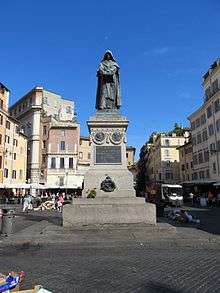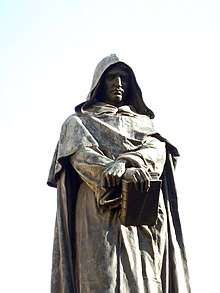Statue of Giordano Bruno
The Statue of Giordano Bruno, created by Ettore Ferrari, was erected at Campo de' Fiori in Rome, Italy, in 1889.

The inscription on the base recites:
A BRUNO - IL SECOLO DA LUI DIVINATO - QUI DOVE IL ROGO ARSE
(English: To Bruno - From the Age he Predicted - Here Where the Fire Burned)
History

The sculptor, Ettore Ferrari, was the Grand master of the Grande Oriente d'Italia, the Masonic jurisdiction of Italy, who were strong supporters of the unification of Italy over the previous Papal rule of Rome. His other sculptures include a monument in Rovigo, Italy, to Giuseppe Garibaldi, who fought for Italian independence and defended French democracy against Prussian imperialism during the Franco-Prussian War, 1870-1871.
On 20 April 1884, Pope Leo XIII published the encyclical Humanum genus. As a response, the Freemasons decided to create a statue of the pantheist Giordano Bruno. The statue was unveiled on 9 June 1889, at the site where Bruno was burnt at the stake for heresy on 17 February 1600, and the radical politician Giovanni Bovio gave a speech surrounded by about 100 Masonic flags. In October 1890, Pope Leo XIII issued a further warning to Italy in his encyclical Ab Apostolici against Freemasonry;[1] he commented on the monument in the following passage:
that eminently sectarian work, the erection of the monument to the renowned apostate of Nola, which, with the aid and favour of the government, was promoted, determined, and carried out by means of Freemasonry, whose most authorised spokesmen were not ashamed to acknowledge its purpose and to declare its meaning. Its purpose was to insult the Papacy; its meaning that, instead of the Catholic Faith, must now be substituted the most absolute freedom of examination, of criticism, of thought, and of conscience: and what is meant by such language in the mouth of the sects is well known.[2]
Present day
According to a 2008 article in the New Yorker by Joan Acocella, a noted American journalist, "Every year, on the anniversary of his execution, various groups of freethinkers — Masons, atheists, pantheists — gather at the monument, and a representative of Rome's mayoralty places a wreath at its feet." [3]
A statue of a stretched human figure standing on its head designed by Alexander Polzin depicting Bruno's death at the stake was placed in Potsdamer Platz station in Berlin, Germany on March 2, 2008.[4]
References
- Eugen Lennhoff, Oskar Posner, Dieter A. Binder: Internationales Freimaurer-Lexikon. 5. überarbeitete Auflage. Herbig Verlag. ISBN 978-3-7766-2478-6
- http://w2.vatican.va/content/leo-xiii/en/encyclicals/documents/hf_l-xiii_enc_18901015_apostolico-seggio.html
- http://arlindo-correia.com/060109.html
- http://bruno-denkmal.de/index.html Bruno-Denkmal website in German
External links
